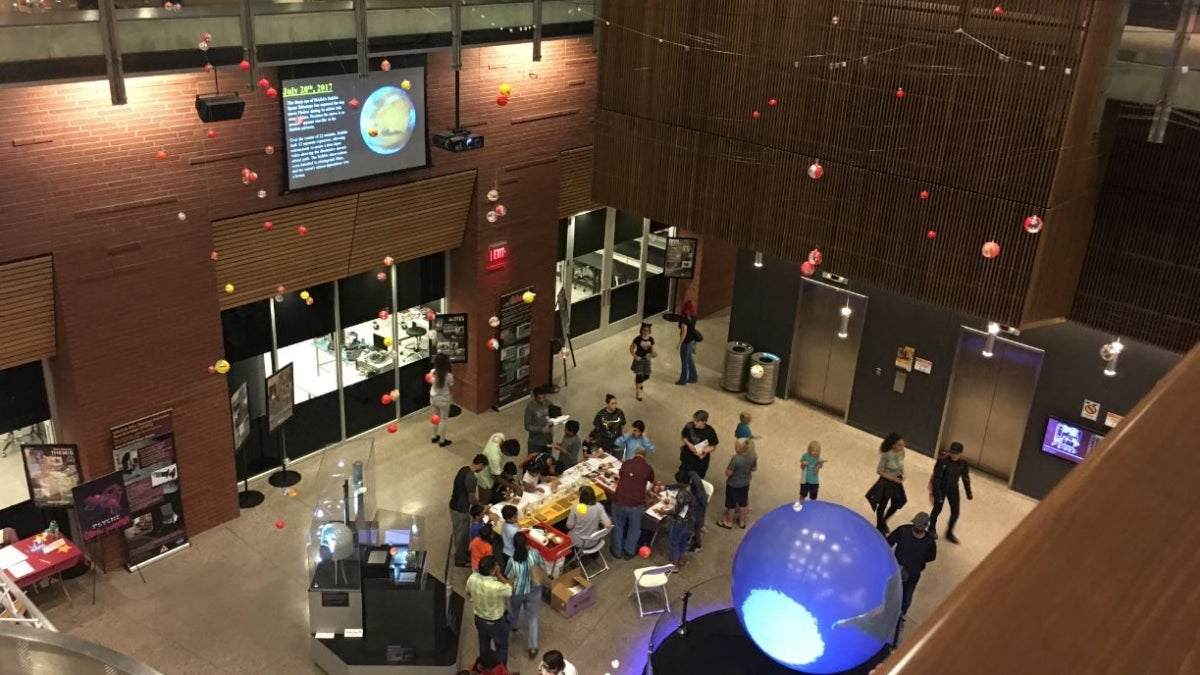Choose your favorite star at ASU’s new art and science exhibit

Volunteers string out stars on Earth and Space Exploration Day. Each globe represents a specific star in the solar neighborhood and was decorated by a child participant. Photo credit: ASU
Our Milky Way Galaxy has hundreds of billions of stars and is more than 100,000 light-years across. So how do you pick your favorite star? Arizona State University's School of Earth and Space Exploration may be able to help.
A new art installation, located in the school’s Tempe campus headquarters in Interdisciplinary Science and Technology Building IV, depicts our solar neighborhood and includes 66 of the nearest stars to the sun, including the sun itself. The exhibit also includes the Alpha Centauri system, Sirius, Altair and Procyon.
The exhibit is the brainchild of Steve Desch, an astrophysicist with the School of Earth and Space Exploration. He was looking for a way to convey our place in space and show the solar system in three dimensions.
“The aim of the exhibit is to provide an intuitive, visual representation of what stars look like and how near or far they are to each other,” Desch said. “If you didn’t know how close Luyten's star is to Procyon, this is your chance to see for yourself!”
The exhibit is the completion of a "STEAM" (science, technology, engineering, arts and math) project as part of the ASU-led and NASA-funded Nexus for Exoplanet System Science program, or “ASU-NExSS” for short. Desch, who is the principal investigator for ASU-NExSS, leads a team of astrophysicists, geophysicists, biologists and astrobiologists to help devise a strategy for looking for life on exoplanets around other stars.
The new art exhibit, which hangs in the building’s Gallery of Scientific Exploration, was created with the help of visitors to the school’s recent Earth and Space Exploration Day. Participants were assigned a specific nearby star and given information about it, then they decorated and personalized a plastic globe representing the star. Many of the stars are quickly seen to be part of double or even triple star systems. Each star is decorated with the actual color of the star. There are three blue stars, each of which is a well-known, bright star in the sky (Sirius, Altair, Fomalhaut). But most are red, and only a few are yellow like the sun. Each star was then expertly arranged nearly exactly as it would be in space.
Some of the stars are famous to fans of science fiction. For example, 40 Eridani is host to the planet Vulcan in Star Trek. The triple star 70 Ophiuchi is host to the planet of House Harkonnen in "Dune." But many of the depicted stars have planets in fact, not fiction.
“Amazingly, and appropriately for our ASU-NExSS project, although these are the 49 closest stellar systems, at least 8 of them are known to have exoplanets,” Desch said.
The exhibit will be on display through January 2019 in the Interdisciplinary Science and Technology Building IV. The building is open to the public from 9 a.m. to 5 p.m. Monday–Friday and from 1 to 4 p.m. Saturday. To learn more about stars, our solar system and the universe, visitors may also want to visit the building’s Marston Exploration Theater for a 3D planetary show.
More Science and technology

ASU and Deca Technologies selected to lead $100M SHIELD USA project to strengthen U.S. semiconductor packaging capabilities
The National Institute of Standards and Technology — part of the U.S. Department of Commerce — announced today that it plans to…

From food crops to cancer clinics: Lessons in extermination resistance
Just as crop-devouring insects evolve to resist pesticides, cancer cells can increase their lethality by developing resistance to…

ASU professor wins NIH Director’s New Innovator Award for research linking gene function to brain structure
Life experiences alter us in many ways, including how we act and our mental and physical health. What we go through can even…


